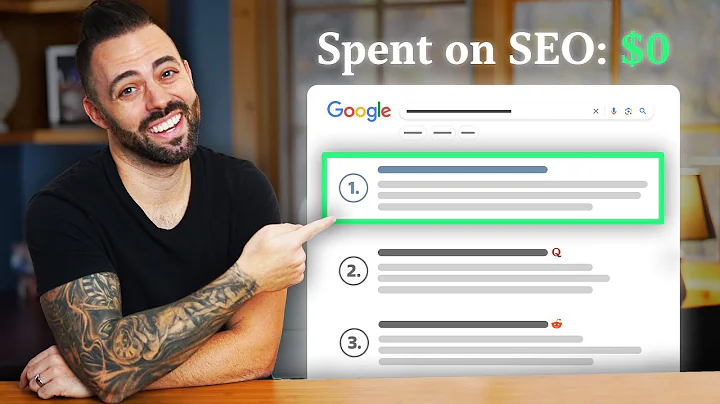Mastering Ecommerce SEO: Learn from IKEA's Strategy
Table of Contents:
- Introduction
- The Power of SEO in E-commerce
- Analyzing Ikea's SEO Strategy
- Understanding User Intent in E-commerce SEO
- The Importance of Category Pages
- Internal Linking in E-commerce Websites
- The Benefits of a Flat Website Architecture
- Optimizing Your Category Pages for SEO
- The Role of Subcategories in E-commerce
- The Impact of Room-based Optimization
- Conclusion
The Power of SEO in E-commerce
In today's digital age, having a strong online presence is vital for the success of any e-commerce business. And one of the most effective ways to boost your visibility and drive organic traffic to your website is through search engine optimization (SEO). By optimizing your website and content for search engines, you can improve your rankings in search results, attract more potential customers, and ultimately increase your sales. In this article, we will explore the power of SEO in e-commerce and delve into the strategies used by a prominent brand, Ikea, to dominate the online market.
Analyzing Ikea's SEO Strategy
When it comes to e-commerce giants, Ikea stands out as a prime example of a brand that has mastered the art of SEO. With a staggering 182 million monthly clicks in organic traffic, Ikea has solidified its position as a leader in the industry. But what sets their SEO strategy apart? One key aspect is their emphasis on category pages rather than product pages. By focusing on category pages, Ikea ensures that they capture a broader range of search queries, catering to different user intents. This approach allows them to tap into a higher volume of organic traffic and increase their chances of conversion.
Understanding User Intent in E-commerce SEO
User intent plays a crucial role in effective e-commerce SEO. It refers to the underlying purpose or intent behind a user's search query. Traditionally, there are four types of user intents: informational, navigational, transactional, and commercial. By understanding the different intents behind user queries, you can tailor your content and website architecture to meet their specific needs. Ikea excels in this aspect by providing a seamless user experience that guides visitors through their website, regardless of their intent. From navigational intent to informational and commercial intent, Ikea ensures that every stage of the buying journey is addressed.
The Importance of Category Pages
Category pages serve as the focal point of e-commerce SEO. These pages act as hubs that attract the majority of organic traffic and guide users towards relevant products or services. Ikea's success lies in their recognition that category pages should be the primary focus of their SEO efforts. By optimizing these pages for a wide range of relevant keywords, Ikea maximizes their visibility in search engine results pages (SERPs) and increases their chances of ranking higher. This strategy of prioritizing category pages over individual product pages allows them to capture a larger market share and improve their overall search visibility.
Internal Linking in E-commerce Websites
A well-structured internal linking system is vital for SEO success in e-commerce websites. Internal links not only guide users through your site but also assist search engines in understanding the hierarchy and relevance of your content. Ikea showcases a strong internal linking strategy, ensuring that their category pages act as connecting points for relevant subcategories and products. By avoiding orphan links and ensuring the easy navigation of their website, Ikea enhances user experience and helps search engines crawl and index their content more effectively.
The Benefits of a Flat Website Architecture
A flat website architecture is essential for both user experience and SEO. A flat architecture ensures that every page on your website is easily accessible, usually within three clicks from the home page. Ikea's website exemplifies this by providing a cohesive structure that facilitates seamless navigation. With a flat architecture, Ikea eliminates unnecessary clicks and helps users find the information or products they desire quickly. This user-friendly approach not only enhances engagement but also improves search engine crawling efficiency, leading to better rankings in organic search results.
Optimizing Your Category Pages for SEO
To harness the power of category pages, it is crucial to optimize them effectively for SEO. This involves conducting thorough keyword research to identify relevant and high-volume search terms. By strategically incorporating these keywords in your category page titles, headings, and meta descriptions, you can significantly improve your visibility in search results. Additionally, optimizing the product descriptions and images on your category pages can further enhance their SEO value. Ikea's category pages exhibit well-optimized content, ensuring that they rank prominently in SERPs and attract a steady stream of organic traffic.
The Role of Subcategories in E-commerce
Subcategories play a vital role in e-commerce SEO, allowing you to further refine your website's organization and cater to specific user needs. Ikea leverages subcategories effectively by making use of them within their category pages. This approach not only helps users find relevant products more efficiently but also allows Ikea to target long-tail keywords and capture niche markets. By incorporating subcategories with optimized content and targeted keywords, Ikea establishes itself as a comprehensive solution provider, maximizing their visibility and organic traffic potential.
The Impact of Room-based Optimization
In addition to category-focused optimization, Ikea goes above and beyond by dedicating a separate section of their website to room-based optimization. By highlighting specific rooms such as bedrooms, living rooms, bathrooms, and dining rooms, Ikea is able to capture a different subset of keywords and cater to users searching for room-specific furniture. This approach demonstrates the brand's commitment to providing a comprehensive shopping experience, further strengthening their SEO efforts and capturing a wider range of potential customers.
Conclusion
In conclusion, SEO is an indispensable component of any successful e-commerce strategy. By analyzing Ikea's SEO approach, we can glean valuable insights into how to optimize our own e-commerce websites. Prioritizing category pages, understanding user intent, implementing effective internal linking, maintaining a flat website architecture, and optimizing content are all key elements that contribute to improved SEO performance. By following these strategies and continually adapting to search engine algorithms, you can enhance your online visibility, attract more organic traffic, and ultimately drive sales in the fiercely competitive e-commerce landscape.
Highlights:
- The power of SEO in boosting e-commerce success
- Analyzing Ikea's domination in the online market
- Understanding and catering to user intent in e-commerce SEO
- The importance of category pages and their optimization
- Leveraging internal linking and flat website architecture for enhanced SEO
- Optimizing category pages with targeted keywords and compelling content
- Harnessing the potential of subcategories for refined targeting
- Expanding reach with room-based optimization strategies
- Key takeaways for implementing effective e-commerce SEO
FAQ:
Q: How does SEO impact e-commerce success?
A: SEO plays a critical role in driving organic traffic to e-commerce websites, improving search engine rankings, and increasing visibility, ultimately leading to higher sales.
Q: What sets Ikea's SEO strategy apart in the e-commerce industry?
A: Ikea focuses on optimizing category pages rather than product pages, capturing a broader range of search queries and increasing their chances of conversion.
Q: How does Ikea cater to user intent in their SEO strategy?
A: Ikea excels in understanding different user intents, providing a seamless user experience that addresses navigational, informational, and commercial intent throughout the buying journey.
Q: Why are category pages important in e-commerce SEO?
A: Category pages attract a large portion of organic traffic and serve as hubs that guide users towards relevant products or services.
Q: How does internal linking impact e-commerce SEO?
A: Well-structured internal linking helps guide users and search engines, improving website navigation and content crawling efficiency.
Q: What is the significance of flat website architecture in e-commerce SEO?
A: Flat website architecture ensures that every page is easily accessible, enhancing user experience and search engine crawling efficiency.
Q: How can category pages be optimized for SEO?
A: Optimizing category pages involves thorough keyword research, strategic keyword integration, and optimizing product descriptions and images.
Q: What role do subcategories play in e-commerce SEO?
A: Subcategories allow for more refined organization and targeting, helping users find specific products efficiently and capturing niche markets.
Q: How does room-based optimization impact e-commerce SEO?
A: By showcasing room-specific furniture and optimizing content accordingly, websites can target a different subset of keywords and provide a comprehensive shopping experience.
Q: What are the key takeaways for implementing effective e-commerce SEO?
A: Prioritize category pages, understand user intent, leverage internal linking and flat website architecture, optimize content, and adapt to search engine algorithms for improved SEO performance.







